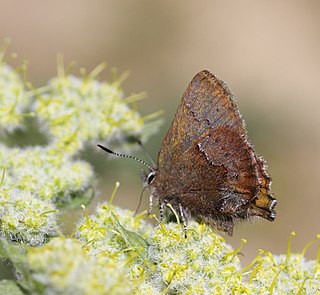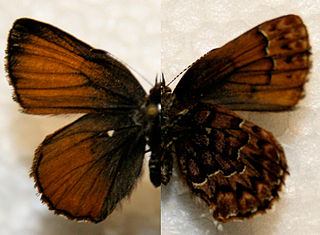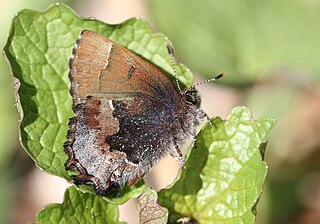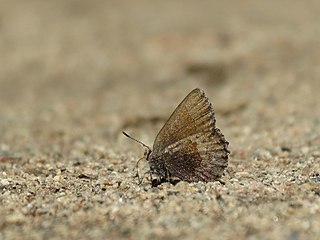
The San Bruno elfin is a U.S. federally listed endangered subspecies that inhabits rocky outcrops and cliffs in coastal scrub on the San Francisco Peninsula. It is endemic to this habitat in California. Its patchy distribution reflects that of its host plant, broadleaf stonecrop.

The western pine elfin is a North American butterfly that ranges from British Columbia east to Maine and south to southern California, Arizona, and New Mexico. Males are brown and females are orange-brown, with both having bold patterned hind wings. The top of the wings have dark bars with a lighter chevron shaped margin. The body is 19–32 mm in length and has no tail.

The genus Callophrys consists of butterflies in the family Lycaenidae. It is apparently not monophyletic, but which of the taxa currently considered junior synonyms of Callophrys are valid genera remains to be determined.
The genus Incisalia, described by Samuel Hubbard Scudder in 1872, consists of butterflies in the family Lycaenidae found in North America. They are commonly called elfins.

Callophrys henrici, the Henry's elfin or woodland elfin, is a North American butterfly in the family Lycaenidae. In Canada it is found from southern Manitoba to southern Nova Scotia. It has two main groups of populations in the United States; the first is found along the Atlantic Coast and uses various hollies (Ilex) as host plants; and the second is found mainly in the north and the Appalachians where they use redbud as a host plant. Henry's elfin is increasing in New England because of an introduced buckthorn it now uses as a host plant. It is listed as a species of special concern in the US state of Connecticut.

Callophrys irus, the frosted elfin, is a species of Lycaenidae that is native to North America.

Callophrys lanoraieensis, the bog elfin, is a species of Lycaenidae that is native to North America.

Callophrys niphon, the eastern pine elfin, is a species of Lycaenidae that is native to North America.

Callophrys augustinus, the brown elfin, is a species of butterfly of the family Lycaenidae, found from Alaska to northern Mexico. One of its subspecies, C. augustinus iroides, is known as the western elfin.

Callophrys polios, the hoary elfin, is a butterfly of the family Lycaenidae. It is listed as a species of special concern and believed extirpated in the US state of Connecticut.

Callophrys mossii, commonly known as Moss's elfin, stonecrop elfin or Schryver's elfin, is a species of butterfly native to North America in the family Lycaenidae. It is found from British Columbia south to southern California and east to Wyoming and Colorado in isolated populations. The habitat consists of rocky outcrops, woody canyons and cliffs.

Callophrys xami, commonly referred to as the xami hairstreak or green hairstreak, is a butterfly included in the subgenus Xamia and the genus Callophrys in the family Lycaenidae. It was described by Tryon Reakirt in 1867. Other common names for this species, depending on the region, include green hairstreak and elfin. C. xami is considered to be a very rare species of butterfly, and its typical range is in southern Arizona and Texas including down south to Guatemala. The juniper hairstreak and the silver-banded hairstreak butterflies are similar species, but both differ significantly from C. xami in regards to the postmedian white line running across the butterfly wings.










